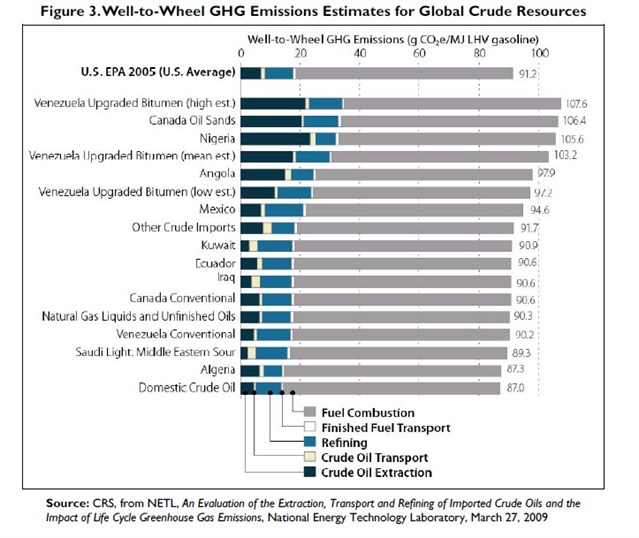Canadian Oil Sands and Climate Change
 A new report has been issued which casts further light on the extent to which Canadian oil sands contribute to climate change.
A new report has been issued which casts further light on the extent to which Canadian oil sands contribute to climate change.Released last week by the U.S. Congresional Research Service, a branch of the U.S. Library of Congress, the report sseks to clarify the debate on Alberta’s oilsands by analyzing their greenhouse gas emissions and how those emissions compare to other sources of crude oil.
The report notes that recent congressional interest in U.S. energy policy has focused in part on ways through which the United States could secure more economical and reliable crude oil resources both domestically and internationally.
It states that many forecasters identify petroleum refined from Canadian oil sands as one possible solution. But increased petroleum production from Canadian oil sands is not without controversy, says the report as many have expressed concern over the potential environmental impacts.
These impacts may include increased water and natural gas use, disturbance of mined land, effects on wildlife and water quality, trans-boundary air pollution, and emissions of greenhouse gases (GHG) during extraction and processing.
A number of key studies in recent literature have expressed findings that GHG emissions from the production of Canadian oil sands crudes may be higher than those of other crudes imported, refined, and consumed in the United States.
The studies identify two main reasons for the increase:
(1) oil sands are heavier and more viscous than lighter crude oil types on average, and thus require more energy- and resourceintensive activities to extract; and
(2) oil sands are compositionally deficient in hydrogen, and have a higher carbon, sulfur, and heavy metal content than lighter crude oil types on average, and thus require more processing to yield consumable fuels.
Selected Findings from the Primary Published Studies
CRS surveyed the available literature, including the U.S. Department of State-commissioned
study in the Environmental Impact Statement for the Keystone XL pipeline project. The literature reveals the following:
• despite differences in the design and input assumptions of the various studies,
Canadian oil sands crudes are on average somewhat more GHG emission-intensive
than the crudes they would displace in the U.S. refineries, with a range of increase
from 14%-20% over the average Well-to-Wheel emissions of other imported crudes;
• discounting the final consumption phase of the life-cycle assessment (which can
contribute up to 70%-80% of Well-to-Wheel emissions), Well-to-Tank (i.e.,
production) emissions from Canadian oil sands crudes have a range of increase from
72%-111% over the average Well-to-Tank emissions of other imported crudes;
• Canadian oil sands crudes, on a Well-to-Wheel basis, range from 9%-19% more
emission-intensive than Middle Eastern Sour, 5%-13% more emission-intensive than
Mexican Maya, and 2%-18% more emission-intensive than various Venezuelan
crudes; and
• the estimated effect of the Keystone XL pipeline on global GHG emissions remains
uncertain, as some speculate that its construction would encourage an expansion of
oil sands development, while others suggest that the project would not substantially
influence either the rate or magnitude of oil extraction activities in Canada or the
overall volume of crude oil transported to and refined in the United States.

CRS Analyst Richard Lattanzio notes “the estimated effect of the proposed Keystone XL pipeline on the U.S. GHG footprint would be an increase of 3 million to 21 million metric tons of GHG emissions annually (equal to the annual GHG emissions from the combustion of fuels in approximately 588,000 to 4,061,000 passenger vehicles.”
Some have argued that this very wide range does not provide a clear path to guide policy action.
“The big challenge for Alberta’s oil industry, then, is to figure out how to reduce the carbon intensity of tar-sands oil,” notes Adam Brandt, an engineering professor at Stanford, quoted in a National Post article.
“The hope,” he says, “is that as the science improves, they can continue to reduce these emissions, and reduce this difference between the oil sands and conventional oil.”
You can return to the main Market News page, or press the Back button on your browser.

